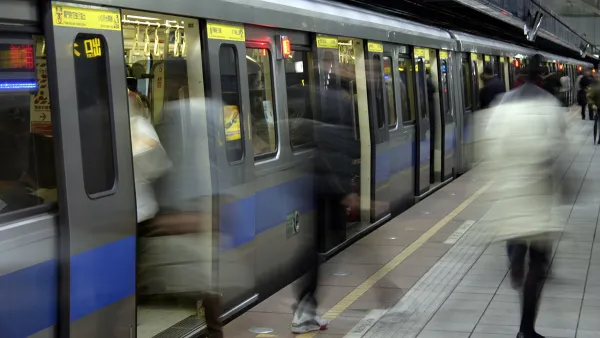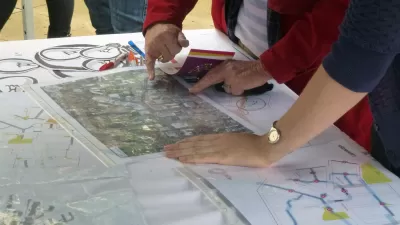Infill

The Coolest Buildings Aren't Green
Creating 'greener' buildings will help address climate change... right?

Critiquing the 'Twenty Percent' Argument Against Transit Funding
This post critiques a common argument against federal support for public transit: that transit gets 20 percent of transportation spending yet has a much lower market share.
Op-Ed: Reintroduce California's Historic Restoration Tax Credit
Despite a veto by Governor Jerry Brown, California’s Assembly Speaker Toni Atkins should keep trying to pass legislation to encourage preservation, says Bay area preservation architect Jerri Holan.

How Planners Can Help Cities Thrive
For planners, the key to moving a city’s vision for development forward is to value public as well as private investment in projects, according to urban planner and author Howard M. Blackson III.
Ritzy Neighborhoods Struggling Against Infill
The market forces that push developers and landowners to build “more” and “bigger” have cropped up in some of the swankiest neighborhoods in Portland. So far, neighbors who oppose the projects are finding scant legal recourse to prevent the changes.
Removing the Obstacles to Infilling Los Angeles
City leaders from the Mayor on down recognize that infill development is necessary to create a more livable Los Angeles. So why does the public sector allow so many obstacles to stand in the way of small-scale development?
10 Principles for Smart Growth in Existing Communities
Frustrated by what's passing as "smart growth" and "transit oriented development," Bill Adams postulates ten refinements (or less subtly stated clarifications) of the principles of smart growth and new urbanism.
America's Housing Stock in Need of Triage
In rising to meet America's changing housing needs and demands, not every community is positioned to pull it off. What to do? Painful though it is, Ben Brown suggests triage.
Should Communities Encourage, Not Stifle, Mansionization?
As cities across the country consider ways to limit teardowns and large home construction in established neighborhoods, Anthony Flint argues that communities should be flattered by "mansionization" and accommodating to this form of smart growth.
Infill Development Picks Up Speed Across the U.S.
A report released this week by the U.S. EPA finds that 71 percent of the country's large metro regions saw an increase in the development of infill housing over the latter half of the last decade. Greenfield development still dominates, however.
Skepticism, Economics, and Regulations Choking Development in Minneapolis
Stringent zoning, high costs, and a culture of skepticism directed at developers have hampered efforts to introduce infill redevelopment into some of Minneapolis' most prime locations.
A Tale of Two Shopping Centers
As the global recession continues to hit the global economy, shopping centers take on two distinct development patterns in developed and developing nations.
The Ecological Value of Lawns
I appreciate natural environments. I have always enjoyed walking in wilderness and cycling on rural roads, and I understand the ecological value provided by undeveloped lands, which include clean water, air and wildlife habitat. I also enjoy local fresh vegetables and fruits and so appreciate the value of preserving regional farmlands. Planners call these "greenspace," or more generally "openspace" since some, such as deserts and waterways, are open but not necessarily green.
Redfields: A New Flavor of Infill
Following an ill-fated foreclosure in 2009, a residential project in Libertyville, IL finally finds its way while demonstrating the potential for an emerging field of redevelopment, reports Ann Dillemuth.
Urban Infill a New Target for Modular Homebuilders
Urban infill housing is becoming a major part of business for large homebuilders, even those building modular homes.
Cheap transport and cheap housing: is there a tradeoff?
A few months ago, I updated a city rating system (available at http://lewyn.tripod.com/livable09) that evaluated cities' "livability" by rating crime rates, transit-friendliness, and cost of housing. Plenty of cities did very well on the first two criteria. For example, New York is now safer than most big cities, and of course is by far the best city in the U.S. for public transit. But its housing costs are dreadfully high. The same was true of Boston and San Francisco (which, if only crime and transit were considered, would rank second and third for livability).
Sideways Train Bridges as Precursors to Skyscrapers
The early skyscrapers were inspired by the idea of turning steel train bridges on their sides. This episode of 99% Invisible explains.
Moving Infill from Policy to Reality
A new organization in California is advocating for reforms to make infill a more viable option for communities around the state of California. Their three talking points: redevelopment, CEQA reform, and parking requirements.
Bulldozing Quincy, Mass - and Building it Back Up
Most cities don't get the chance to start from scratch. But Quincy, Mass. plans to raze most of its 50-acre center and build it anew with the aid of a private developer's upfront funding - a plan that may rewrite the rules of urban development.
Los Angeles' First New Office High Rise in 22 Years Approved
The skyscraper, developed by Thomas Properties and financed by Korean Air, required a new signage district and a TFAR transfer. The development will provide a link between the Financial District and the emerging Figueroa Entertainment Corridor.
Pagination
Urban Design for Planners 1: Software Tools
This six-course series explores essential urban design concepts using open source software and equips planners with the tools they need to participate fully in the urban design process.
Planning for Universal Design
Learn the tools for implementing Universal Design in planning regulations.
Smith Gee Studio
City of Charlotte
City of Camden Redevelopment Agency
City of Astoria
Transportation Research & Education Center (TREC) at Portland State University
US High Speed Rail Association
City of Camden Redevelopment Agency
Municipality of Princeton (NJ)


































